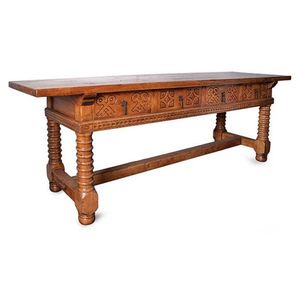19th Century Mahogany Card Table with Lyre Supports
You must be a subscriber, and be logged in to view price and dealer details.
Subscribe Now to view actual auction price for this item
When you subscribe, you have the option of setting the currency in which to display prices to $Au, $US, $NZ or Stg.
- A/f, as Inspected - The letters "A/F" or "as inspected" as part of a description is the cataloguer's shorthand for "all faults" or "as found", meaning the item has some type of damage or deficiency, it is of uncertain date or provenance, and/or that the seller takes no responsibility for the completeness of the item or the accuracy of the description.
- Regency Period - The Regency period in English furniture design refers to the period when King George III, was declared unfit to rule in 1811, and his son ruled as proxy as Prince Regent, until 1820, and then, after the death of his father as George IV until his death in 1830. The Regency period was preceded by the Georgian period (George I, George II, and George III: 1714 - 1811), and was followed by the William IV period, which only lasted until 1837 when William IV died as was succeeded by Queen Victoria.
- Mahogany - Mahogany is a dense, close grained red-coloured timber from the West Indies and Central America. It was first imported into Europe in the the early 18th century and its use continued through the 19th century. It was popular for furniture making because of its strength, the wide boards available, the distinctive grain on some boards, termed flame mahogany and the rich warm colour of the timber when it was polished.. The "flame" was produced where a limb grew out from the trunk of the tree, and this timber was usually sliced into veneers for feature panels on doors, backs and cornices.
Some terms used to describe mahogany relate to the country from which it originally came, such as "Cuban" mahogany, "Honduras" mahogany etc. However unless the wood has been tested the names assigned are more a selling feature, rather than a true indication of the timber's origin. - Lyre - Attributed to the 18th century designer Robert Adam, the back splat of a chair or sthe supports of a table are in the form of a lyre, a Greek musical instrument similar to a harp.
In shape it resembles two reversed scrolls.
Chairs continued to be made in this style for at least the next fifty years.
In Australia many cedar chairs and tables have survived dating to the 1830s and 1840s, featuring the lyre shape in the back splats and as supports for small tables. - Castors - Wheels, fitted especially to chair legs, couches, tables and some smaller pieces of furniture, to enable them to be easily moved about. The earliest castors were of brass, with shanks fitting into the base of the leg, and the wheels often made of leather. In the late 18th century, brass 'bucket' or 'cup' castors were introduced, either rounded or square, fitting directly over the end of the leg and held in place with screws. The wheels were generally solid brass. Bucket/cup castors continued in use throughout the 19th century and indeed are still made today. In the later 19th century wheels were sometimes made of wood, china, either white or brown, and sometimes of steel.
- Lyre Motif - The lyre motif is an ancient decorative design that is believed to have originated in ancient Greece, where the lyre was a popular musical instrument. The lyre itself was often decorated with ornate carvings and designs, including the iconic lyre motif.
In ancient Greek mythology, the lyre was associated with the god Apollo, who was the patron of music and the arts. The lyre was said to have been invented by the god Hermes, who presented it to Apollo as a gift. As a result, the lyre became a symbol of creativity, inspiration, and artistic expression.
The lyre motif typically features a curved or S-shaped body, with strings extending upwards from the base. The motif was often used in architectural decoration, as well as on pottery, jewellery, and other decorative objects.
This item has been included into following indexes:
Visually similar items

Regency mahogany card table, c. 1820 with ebony stringing, the fold-over top with canted corners above Greek key strung frieze with Paterae mouldings, on two vase shaped supports on a small rectangular base, raised on four down swept legs with brass termin

Regency plum pudding mahogany and rosewood banded foldover tea table, circa 1815, reeded supports terminating with brass sabots and casters, ebony and boxwood stringing, nice old colour, fine example, 74 cm high, 91 cm long, 90 cm deep

A Victorian card table, of rectangular shape in burr walnut, standing on turned stretcher base with carved legs. Height 71 cm, width 87 cm depth 45.5 cm

A 17th century Spanish style side table, with a rectangular top, above four geometric panelled frieze drawers, 82.5 x 237 x 60.5 cm
